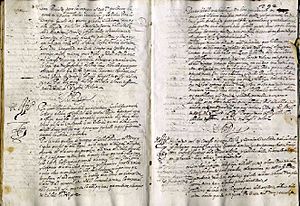Archivo General de Simancas facts for kids

|
|
| Location | Simancas, Province of Valladolid, Castile and León, Spain |
|---|---|
| Type: | Non-movable |
| Criteria: | Archive |
| Designated: | 10 November 1997 |
| Reference #: | RI-AR-0000010 |
The General Archive of Simancas (often called AGS) is a very important official archive in Spain. It is located inside the Castle of Simancas, in the town of Simancas, near Valladolid. It was started in 1540. This makes it the first official archive for the Crown of Castile, which was the main kingdom in Spain at that time.
This archive holds many old and important documents. These papers tell the story of the Spanish monarchy and its history. When Spain was strong, more documents arrived regularly. When times were tough, the archive sometimes faced challenges. A big moment for the archive was in 1588. That's when Philip II of Spain created special rules for how the Simancas Archive, and others, should be managed. The archive also suffered damage during the Peninsular War (1808-1814), when France invaded Spain.
Today, the AGS is a cultural place supported by the Ministry of Culture of Spain. Its main jobs are to keep old documents safe, organize them, and help people research them. Because of this important work, the archive is known as one of the best places in Spain for preserving historical records.
In 2017, UNESCO recognized the General Archive of Simancas as a World Heritage Site. It was added to their Memory of the World Programme. This program protects important documents and collections from around the world.
Where is the Archive?

The archive is in Simancas, a town about 10 kilometers from Valladolid. This spot was chosen carefully. It was a strong, fortified place that was easy to defend.
During the Reconquista (a long period when Christian kingdoms took back land from Muslim rule), Simancas was an important border town. Later, its location between the kingdoms of León and Castile gave it a political role. After the city of Toledo was conquered in 1085, Simancas became less important. By the 13th century, it was just a small town near Valladolid. However, in 1465, King Henry IV of Castile gave Simancas more power to keep the town loyal to him.
For a long time, people thought Simancas castle was built during the Reconquista. But in 1917, a historian named Francisco Rodríguez Marín found out something new. He showed that the current castle was built between 1467 and 1480. It was built by Admiral Alonso Enriquez, after an older castle was torn down. The castle has been changed a lot over hundreds of years. So, not much of its original look remains.
Why was a castle chosen for an archive? After the Christian kingdoms moved their borders south, the castle was no longer needed for defense. It was then used for other things, like storing weapons or as a state prison. These uses happened at the same time it became an archive. Also, a powerful person named Francisco de los Cobos, who was close to King Charles I, helped make sure the archive was placed in Simancas.
The castle was not built to hold documents or for people to do research. This caused some problems for the archivists over time. The biggest worry was the risk of fire. Since the building was also a prison, there was a higher chance of records burning down. Also, because it was a fortress, it was a target during wars, like the Spanish War of Independence.
The castle's decorations were not about learning or books. Instead, they showed the power of the king. For example, one of the doors has the coat of arms of Philip II of Spain. It was also hard for researchers to work there for a long time. But improvements have been made over the years to make it easier for them.
See also
 In Spanish: Archivo General de Simancas para niños
In Spanish: Archivo General de Simancas para niños
- List of collections in the Archivo General de Simancas (in Spanish)


